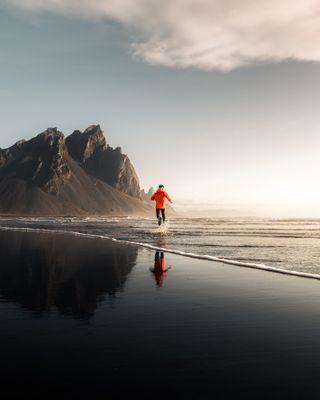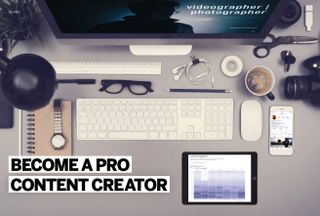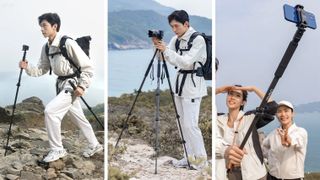In today’s commercial photography sphere, shoots are fast, and change seems rapid. Years ago, a creative brief might have taken months to come together, with a collaborative back-and-forth process between a pro shooter and the client or agency.
Today, social media (mainly Instagram), improved camera technology and the way that we consume media – on our screens rather than just billboards and magazines – means that the process has become much quicker, and arguably more democratized than ever before.
Read more: 20 famous photographers you should follow on Instagram
Social media has paved the way for a new, savvy kind of digital photographer – the content creator. Content creation can be applied to anyone who creates media – writers, bloggers, photographers and videographers – with a specific audience in mind. But it can be hard to know how to pivot from traditional photography into content creation.
Of course, there's a lot of competition out there, but there are some things that you can do to improve your chances of going viral. Here we’ll be explaining the basics of modern content creation and how it works in relation to taking photos, along with sharing some advice from a pro.
Before you can create engaging (and profitable) content, though, you’ll need to understand the role of a content creator and realize that it’s about more than just Instagram likes. Creation and curation is a modern art form and a professional pursuit that requires a combination of different skills – creativity, organization and even an understanding of data, to name a few.
You might picture a young, trendy, urban vibe when you think about content creators, but any photographer who is able to create come-back-for-more, dynamic and relevant content for both clients and audience can succeed.
Get the Digital Camera World Newsletter
The best camera deals, reviews, product advice, and unmissable photography news, direct to your inbox!
We’re here to demystify some of the ways that you can get into content creation if you’re a skilled photographer or videographer, how to hone niche skills, and how to transition into the area from a more traditional approach if you’re already a commercial photographer. We also have a pro case study with content creator Keenan Lam.
1. Choose the right platforms
If you’re a professional photographer in 2020 and you’re not on Instagram, where have you been? It used to be that without a decent website, photographers simply wouldn’t be taken seriously. Now, in the age of big data, it’s vital that your social media presence is on top form, and that you understand exactly when, how, why and where to post and share your imagery. If you're not sure where to start, here's 10 tips for Instagram success with your photography.
The huge benefit of sharing images via social media over a traditional website is the added interaction and engagement, all of which will help you to connect with like-minded photographers, followers and hopefully clients. Simple ways to be more interactive include tagging brands in your images, uploading stories, and reaching out to people whose work you admire. If you’re into video and haven’t set up a YouTube channel, consider that too (the best YouTube cameras might help).
Not all content creation happens within the square walls of Instagram posts, of course, and for introverts this constant need to share yourself can be exhausting. If this sounds like you, channel your skills into newsletters, blogging and written photography tips.
2. Carefully curate your content: is it better to specialize or diversify?
Whatever stage you are at with your portfolio of work, at some point you will need to decide whether to shoot images with a niche appeal aimed at a particular demographic – a recognizable, style and aesthetic – or to shoot a wider range of images with a more mass appeal.
The niche approach is great if you specialize in one genre and style and have a very clear consumer in mind, and this way potential clients should know exactly what to expect from you. You may, however, struggle to find as many clients in the first place. If you diversify your photography and shoot a wide range of different looks, brands, people and content, you can certainly attract a wider range of followers and clients, but again, you may put some off.
3. Do your research into content creators
Take a look at the work of most traditional, successful, commercial pros, and you’ll notice that they have a consistent lighting and editing style. They also choose to work alongside brands that share their values and aesthetics, or with companies that they themselves use and love. If you’re trying to break into the area of content creation, you’re unlikely to get any paid gigs if you haven’t got any examples to show potential clients, so producing some original content off of your own back is key.
Make a list of your dream clients, from camera products to coffee brands, then do some solid research into their style of marketing. Have photographers already been creating content for them? How have the images been shot? What language is being used alongside the visual posts? Once you’ve nailed this, try shooting – in your own style, whatever that is – images or videos of that product being used in the real world.
Even on a limited budget, you can create fun content that’s full of personality, without having to rely on an exotic backdrop. Always remember to tag the brands, locations and photo communities that you want to hit up, otherwise your work is very unlikely to reach your intended audience.
4. Make your content relevant
It sounds obvious, but all of your content that’s intended for commercial purposes needs to be created with a target audience in mind. How will follower x feel about this new LED camera light? How old are they? What hobbies do they enjoy? Who else are they following?
All of these questions can help you to get under the skin of your audience and shoot photographs that will appeal to them, perform well and convert into sales for your client. It sounds mercenary, but commercial photography has always been about crafting images and stories that sell – it’s just the platform and approach that has shifted.
5. Use analytics tools
Another brilliant advantage of social media platforms – or disadvantage, if you get too hooked on the numbers – is the ability to see how well certain photographs have done compared to others, and discover who is actually looking at your work. While social media platforms do offer you a limited range of insights on posts, paying for a premium service such as Later.com will offer a more detailed analysis of what your content is doing.
For example, Later.com helps you to plan, schedule and analyze posts across Instagram, Facebook, Pinterest and Twitter, with feedback on the best time of day to post and the most effective hashtags to use. There’s no guarantee that creating similar content will perform as well in the future, but it’s certainly a good approach to use feedback in a positive way.

Videographer and content creator Keenan Lam shares his story for getting into the industry

Keenan Lam is a photographer and videographer who's created content for the likes of Nvidia, Bentley, Nike, Reebok and countless other major players. Keenan is also the founder at Dropcuts.co, an up and coming creative studio specializing in motion graphics, kinetic typography and explainer videos.
Keenan, would you call yourself a content creator, commercial photographer, travel videographer, or a mix of all three?
That’s a tough one. I’d usually say a mix of all three because I do a bit of everything, but if I had to choose, “content creator” would summarise what I do best.
Tell us a bit more about your work...
My career is definitely more video-focused – my income stems from creating video content for brands and business owners. I’ve been fortunate enough to travel quite a bit, creating videos for tourism boards such as Vegas and Bahrain, as well as camera equipment brands and clothing brands.
In addition to that, I work for and run the UK Shooters brand along with @watchluke and the founder @m.visuals.
We’re a community that showcases the best content from photographers and videographers from around the UK. We also host photography events that allow attendees to network, or even test a camera they’re itching to get their hands on. I create the highlight videos for these events!
Then with my Instagram portfolio, you’ll primarily see my travel content, stuff I’ve taken on my trips around the world, as I love to shoot stills along with capturing video. Photography is more of a side-hobby for me so to speak, although I have had some gigs creating photo content for brands – I love the whole creative process.

What’s been your route into the industry?
My route has been a long road of hard work and grinding and reaching out. I created my first paid video project in 2017 for Specsavers during London Fashion Week, as they were looking for a videographer to capture content alongside my friend Luke, their photographer at the time who recommended me.
After the client loved the video, I realized I could potentially take this full time. The first few months were a huge struggle, with tons of failed attempts reaching out to brands and companies, asking if I could create content for them – applying for jobs within the video industry, with no result. I realized I didn’t have enough work in my portfolio for brands to see my value. Skip forward a few months, after completing a bunch of free and low-paid jobs, and the results started to pay off.
Slowly, I started getting more and more work. I posted more regularly on Instagram, built up my social presence and continued developing my style. I then joined the UK Shooters team in August of 2018, and pairing that with my own freelance client work, my career hasn’t been the same since.

What are the most important skills you need to succeed?
I usually say it’s more about your mindset towards success. You have to be determined in this industry, as it’s becoming very saturated and you need to put in the hard work to make sure you stand out. Set achievable goals, attend to them, and slowly work towards your bigger goal. If there’s one skill that I think you should always try and work on, it’s networking and conversational skills. Building rapport with new clients, knowing others in the industry, supporting other creatives – it’s this that will help you get to where you want to be.
The power of word-of-mouth is incredible, and you never know who might be needing your services down the line of your network. I’d also recommend learning how to receive and ask for feedback properly, and allow yourself to analyze what you could do better. Self-awareness in terms of your quality of work is a skill I wish I’d had in the beginning.

What does a typical week look like?
Working freelance, you are always doing something different, travelling to somewhere different. But a majority of it consists of me sitting at my desk and editing video content, or replying to emails and sorting out future projects. I’ll have a few calls a week with the team at UK Shooters, and continue to work on Dropcuts.co, a new project of mine I’m releasing to help people starting out in the video industry to work faster and edit smarter.
Do you approach clients first?
I’m fortunate enough to have a few returning clients each month, as well as new clients finding me through my website, Instagram, or just word of mouth every now and then. If I have a passion project that I really want to work on, then you’ll find me reaching out to brands to see if they’d be interested.
How do you come up with fresh ideas?
I’ve found coming up with the most original ideas pretty hard at times – but I usually search up creatives I look up to, and see what they’ve done that I like. I might also browse films I’m interested in or inspired by, and analyse them to see techniques they might have used and their colour schemes. I then like to take these ideas, break them down, and see how I can piece them back together in a different way, or put my own spin on it. “Don’t try and reinvent the wheel, focus on making it better”: I’m a big fan of this quote.
Keenan's kit list
1. Sony A7 III
2. Variable ND Filter
3. SSDs (lots of them)
4. DJI Ronin-S gimbal
5. DJI Mavic 2 Pro drone
To improve your chances of success, you might also like the best cameras for Instagram, plus here are 20 famous photographers you should follow on Instagram for some inspiration.






